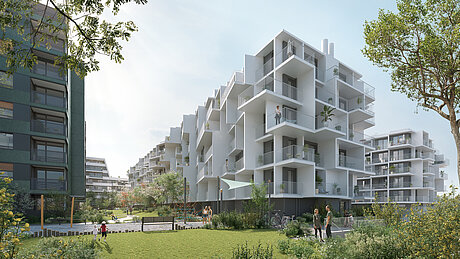
Balcony, access balcony and canopy
Balcony, access balcony and canopy

Keeping thermal bridges to a minimum
When it comes to thermal bridges, balconies and pergolas are among the most critical areas of a building. The comprehensive range of versatile Schöck Isokorb® products has the right solution for every new-build or refurbishment project requirement.
Solutions for shear force transmission
From concrete slabs in high-rise buildings to supporting walls of underground garages: whatever the situation, Stacon® can be used to transmit shear forces in expansion joints free of constraint forces.
Concrete formwork for the perfect frame
Schöck Signo® stop-end panels are used instead of conventional concrete formwork made of timber or polystyrene.
Keeping thermal bridges at the balcony to a minimum
Although balconies are often the most striking visual elements of a building, they are also unfortunately also its "Achilles heel" in terms of thermal performance. After all, it is precisely at these transitions that thermal bridges occur, which in turn leads to greater heat loss, damp walls and mould. In addition to thermal insulation and statics, fire, noise and moisture protection must be taken into consideration and the relevant values adhered to.
Versatile application, unique geometries
Schöck Isokorb® has a wide range of applications: cantilevered balconies or balconies supported by columns, loggias, pergolas and canopies – whatever the situation, this versatile product range has the right solutions for preventing thermal bridges in both new-build and refurbishment projects.
In addition to the standard applications, Schöck Isokorb® can also be used in one-off challenging installation situations. This could be unusual geometries, long cantilever distances or the construction of timber hybrid buildings, for example.

Unparalleled
insulation performance.

Schöck Isokorb®
When it comes to thermal bridges, balconies and pergolas are among the most critical areas of a building. The comprehensive range of versatile Schöck Isokorb® products has the right solution for every new-build or refurbishment project requirement.

Solutions for
shear force transmission.

Schöck Stacon®
From concrete slabs in high-rise buildings to supporting walls of underground garages: whatever the installation situation, it takes considerable effort to ensure that shear forces are distributed in expansion joints free of constraint forces.
Conventional measures inevitably involve using supporting brackets, sliding bearings or lap joints. These systems all take a lot of time and effort to install.

Concrete formwork
for building the perfect frame.

Schöck Signo®
Schöck Signo® stop-end panels are used instead of conventional concrete formwork made of timber or polystyrene. This formwork method offers a high-quality edging when manufacturing prefabricated concrete balconies, floor slabs, walls and stairs at the precast plant.
Ahead of his time
In 1983 Eberhard Schöck revolutionised the construction industry with his invention for minimising thermal bridges at cantilevered components.
This original invention demonstrates his visionary approach and has since gone from strength to strength.






